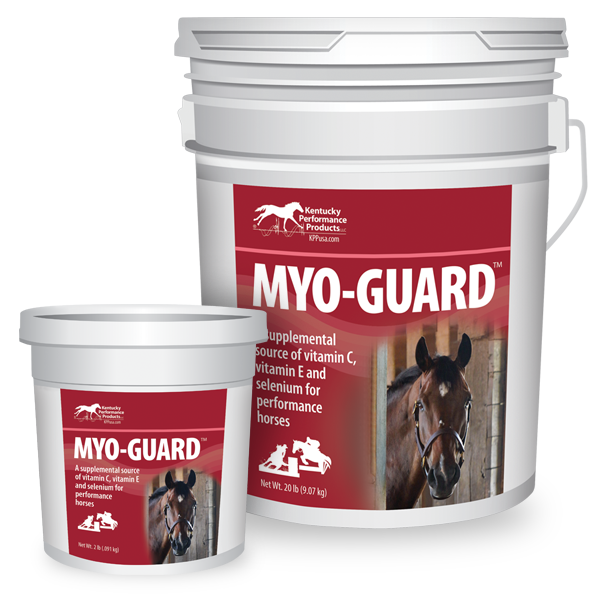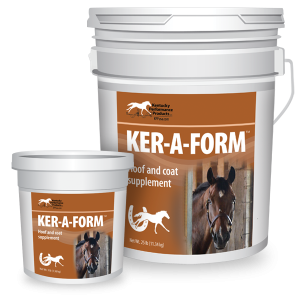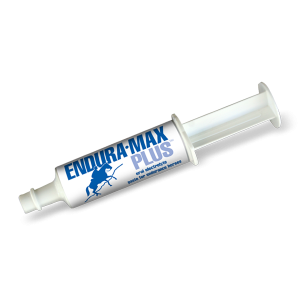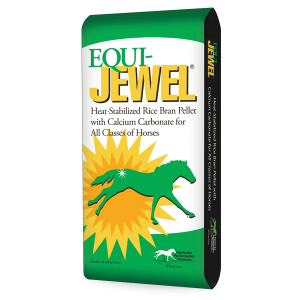Product Description
Why choose Myo-Guard?
Myo-Guard was developed to sustain optimal performance in horses of all types. It provides a blend of antioxidants that support healthy muscle function during training and competition. Horses with healthy muscles have more stamina and strength, are quicker to recovery after vigorous exercise, and are less likely to develop muscle disorders.
Fighting oxidative stress
Antioxidants protect cells and tissues from a normal metabolic process called oxidation, which is the use of oxygen to break down carbohydrates, fats, and protein for energy. A byproduct of oxidation is the formation of free radicals, compounds that damage cells and tissues. This damage is also known as oxidative stress. Horses at rest typically have enough antioxidants to ward off the ill effects of normal oxidative stress, but horses being asked to exercise on a daily basis may need supplementation to meet the increased demand for antioxidants caused by increased muscle activity. In the performance horse, signs of oxidative stress may surface as muscle soreness or stiffness and delayed recovery from intense exercise. Myo-Guard contains a unique blend of antioxidants, including natural vitamin E, selenium, and vitamin C. Supplementing with Myo-Guard helps the horse maintain sufficient antioxidant levels during periods of training and competition.
- Myo-Guard contains natural vitamin E, selenium, vitamin C, and magnesium
- The natural vitamin E in Myo-Guard is preferentially transported throughout the body and is retained in tissues for longer periods of time than synthetic vitamin E
- Myo-Guard helps maintain optimal muscle function, which reduces the incidence of stiffness and soreness after a challenging workout or competition
Recommended For
Fed daily, Myo-Guard supports healthy muscles during training and competition.
In the last decade, exercise physiology and nutritional research have shown that most performance horses require supplemental antioxidants above and beyond what is provided by their daily diet of hay and concentrates. Additional antioxidant requirements are the result of consistent, demanding muscle activity. Providing antioxidants on a daily basis will help maintain adequate antioxidant levels in the body’s tissues so horses have access to them they need them.
Myo-Guard was designed to be fed daily to support adequate antioxidant levels in hard-working horses of all ages.
Myo-Guard is recommended for:
- Horses in a regular training or competition program, including:
- Barrel racers
- Endurance horses
- Eventing horses
- Horses on the show circuit
- Hunters/jumpers
- Polo ponies
- Racehorses
- Reiners
- Western pleasure horses during a long show season
- Working cow horses
- Young horses in training
- Horses that are used heavily (e.g., school horses, trail riding mounts, carriage horses)
- Horses that experience exercise-induced muscle stiffness, soreness, or tying-up
Ingredients
Formulated to support optimal performance.
Myo-Guard is a blend of ingredients chosen because of their ability to support healthy muscle activity. When muscles function properly, horses are able to perform to their highest potential.
Natural Vitamin E
Vitamin E is unique among vitamins in that it is not required for a specific metabolic function. As alpha-tocopherol, vitamin E’s major function appears to be the body’s most important fat-soluble antioxidant. A powerful antioxidant, vitamin E supports healthy cell membranes by reducing free radical-induced damage. Thus, vitamin E is notably essential for the proper function of the reproductive, muscular, nervous, circulatory, and immune systems. Natural is best! Unlike synthetic vitamin E, natural vitamin E is preferentially absorbed and transported throughout the body. It is also retained in tissues for longer periods of time, making it readily available when horses need it most. Myo-Guard contains 1000 IU of natural vitamin E per ounce.
Vitamin C
This antioxidant supports healthy tissues by scavenging oxygen radicals from aqueous solutions, helping to reduce free radical damage. In addition, vitamin C has been found to aid in the regeneration of vitamin E in the body. Once vitamin E inactivates free radicals, it is usually no longer useful to the body. In the presence of vitamin C, however, the antioxidant properties of vitamin E can be restored. Myo-Guard provides 1500 mg of vitamin C (as ascorbic acid) per ounce.
Selenium
Selenium is required for the production of glutathione peroxidase, an enzyme that neutralizes peroxides so they can no longer damage muscle cell integrity by reacting with the cells’ lipid membrane. Selenium works in concert with vitamin E to support a reduction in oxidative stress. One ounce of Myo-Guard provides 1 mg of selenium.
Magnesium
Magnesium is a mineral that supports proper muscle and nerve function. During exercise, magnesium, as well as other electrolytes, is lost in sweat. Much of the body’s magnesium is stored in the skeleton. The transfer from bone to bloodstream is not efficient enough for rapid replacement of magnesium losses through heavy sweating. Therefore, supplementing an equine athlete’s ration with magnesium may be necessary for optimal muscle function. Myo-Guard supplies 3000 mg of magnesium per ounce.
Serving and Storage
Myo-Guard serving instructions:
1 scoop = 1 oz
1 scoop provides 1,000 IU natural vitamin E; 1,500 mg vitamin C; 1 mg selenium
Mix 1 scoop per day in feed ration.
Do not serve more than the recommended amount.
Storage and shelf life:
Store Myo-Guard in a cool, dry place and keep lid tightly closed between uses. Shelf life is 24 months from date of manufacture when stored under suitable conditions.








Holly Jones (verified owner) –
I do NATRC which is endurance with horsemanship obstacles on the trail. You receive two scores, one for horsemanship and one for the horse. The horse is judged on pulse and respiration, and soundness among other things. We were doing OK, but during the last vet check we would have points taken off for grade 1 lameness and attitude (she was tired). The grade 1 lameness is when the judge can see the horse is stiff and tight or could be slightly off on one leg. Grade 1 is not bad, just that the horse is just a little off.
A friend suggested I try Myo-Guard. I feed the product once a day with my mare’s grain. This product is great because I can feed it during competitions.
This is the difference I have seen since starting Myo-Guard. We are having 9 heart beats per minute and 4 breaths at the vet check during the competition. She is checking out SOUND with a great attitude. No muscle soreness. In my competition in October we won our division and we won sweepstakes. Sweepstakes is the highest scoring horse. My mare scored a 98 out of 100! My November ride we won 1st place in horse and 2nd place in horsemanship. We tied for sweepstakes and with the tiebreaker we did not win. I have seen a difference in her performance.
Holly Jones, owner of Rock Creeks Wild Pepper (Mustang)
Waco, Texas
Brittany Schruefer (verified owner) –
My horse experienced some muscle atrophy due to a host of veterinary issues, primarily due to his vitamin E and selenium levels being on the low end of normal. After just one month on Myo-Guard, he is building muscle faster and coming out less stiff than ever before!